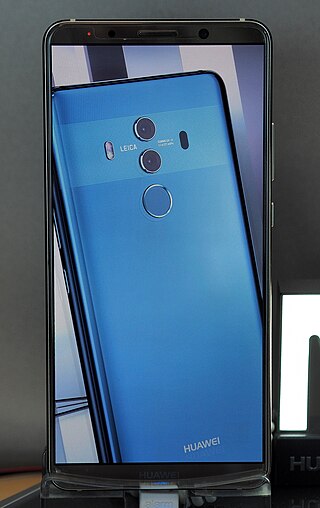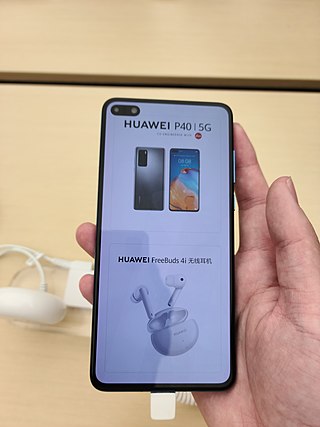Related Research Articles
Google Pixel is a brand of portable consumer electronic devices developed by Google that run either ChromeOS or the Pixel version of the Android operating system. The main line of Pixel products consists of Android-powered smartphones, which have been produced since October 2016 as the replacement of the older Nexus, and of which the Pixel 9, Pixel 9 Pro and Pixel 9 Pro XL are the current models. The Pixel brand also includes laptop and tablet computers, as well as several accessories, and was originally introduced in February 2013 with the Chromebook Pixel.
HiSilicon is a Chinese fabless semiconductor company based in Shenzhen, Guangdong province and wholly owned by Huawei. HiSilicon purchases licenses for CPU designs from ARM Holdings, including the ARM Cortex-A9 MPCore, ARM Cortex-M3, ARM Cortex-A7 MPCore, ARM Cortex-A15 MPCore, ARM Cortex-A53, ARM Cortex-A57 and also for their Mali graphics cores. HiSilicon has also purchased licenses from Vivante Corporation for their GC4000 graphics core.
The Huawei Mate 9 is a high-end Android smartphone, designed and produced by Huawei as part of the Huawei Mate series. It was released on 3 November 2016. It was succeeded by the Huawei Mate 10 series, and later the Huawei Mate 20 series.
Resurrection Remix OS, abbreviated as RR, is a free and open-source operating system for smartphones and tablet computers, based on the Android mobile platform. UX designer and head developer Altan KRK & Varun Date started the project in 2012.

Huawei Mate, formally Huawei Ascend Mate, is a series of high-end HarmonyOS-powered smartphones produced by Huawei, and is one of their flagship products along with the Pura series.

The Huawei Mate 10, Huawei Mate 10 Pro and Huawei Mate 10 Lite are Android smartphones designed and marketed by Huawei as part of the Huawei Mate series. There is also a Mate 10 Porsche design, which has 256 GB of storage but is otherwise identical to the Mate 10 Pro. They were first released on 16 October 2017. Versus the predecessor Mate 9, the Mate 10 pro flagship phone has a faster processor with an integrated neural processing unit, a slightly larger OLED screen (6.0") with a taller 18:9 aspect ratio, a significantly longer battery life and a glass back construction. Chinese and international models are available in dual SIM configuration. It comes with Android 8 and a newer version of Huawei's EMUI interface. All Mate 10 models are unlocked and GSM only. Huawei phones, including the Mate series, are not sold or financed through U.S. carriers due to pressure from U.S. intelligence agencies, though they are available from independent and online retailers.

EMUI is an interface based on Android developed by Chinese technology company Huawei, used on the company's smartphones primarily globally.

Huawei P20 and Huawei P20 Pro are Android smartphones manufactured by Huawei. Unveiled 27 March 2018, they succeed the Huawei P10 in the company's P series line.

The Huawei Pura series is a line of high-end and medium-range smartphones produced by Huawei, based on its proprietary HarmonyOS mobile operating system. The P series was formerly marketed as part of Huawei's larger Ascend brand, and some models were called P smart.

Huawei Mate 20 is a line of Android phablets produced by Huawei, which collectively succeed the Mate 10 as part of the Huawei Mate series. The flagship models, the Mate 20 and Mate 20 Pro, were unveiled on 20 July 2018 at a press conference in London.

The Huawei Mate X is an Android-based high end foldable smartphone produced by Huawei. It was unveiled at MWC 2019 on 25 February 2019 and was originally scheduled to launch in June 2019, but the launch was pushed back to allow for extensive testing in light of the failures reported by users of a similar product, the Galaxy Fold from Samsung. The Mate X launched in China only in November 2019. Huawei announced the Mate Xs on 24 February 2020 as a hardware revision of the original Mate X; it was released in "global markets" outside China in March 2020. The device features a more durable display, improved hinge function and a redesigned cooling system, as well as the newer Kirin 990 5G SoC and Android 10 with EMUI 10.
HarmonyOS (HMOS) is a distributed operating system developed by Huawei for smartphones, tablets, smart TVs, smart watches, personal computers and other smart devices. It has a microkernel design with single framework: the operating system selects suitable kernels from the abstraction layer in the case of devices that use diverse resources.

Huawei Mate 30 is a line of Android-based phablets manufactured by Huawei as part of its Huawei Mate series, and the successor to the Mate 20. The Mate 30 comprises the Mate 30/5G, Mate 30 Pro/5G, and Mate 30 RS Porsche Design, which were unveiled on 19 September 2019 in Munich, Germany.

Huawei P40 is a line of high-end Android-based smartphones manufactured by Huawei. Unveiled on 26 March 2020, they succeed the Huawei P30 in the company's P series line.

Celia is an artificially intelligent virtual assistant developed by Huawei for their latest HarmonyOS and Android-based EMUI smartphones that lack Google Services and a Google Assistant. The assistant can perform day-to-day tasks, which include making a phone call, setting a reminder and checking the weather. It was unveiled on 7 April 2020 and got publicly released on 27 April 2020 via an OTA update solely to selected devices that can update their software to EMUI 10.1.

Huawei Mate 40, Huawei Mate 40 Pro, Huawei Mate 40 Pro Plus and Huawei Mate 40 RS Porsche Design is a high-end Android and HarmonyOS based phablets developed by Huawei for its Mate series, succeeding the Huawei Mate 30 range. They were released on October 22, 2020, at Huawei's Online Global Launch Event.
The Huawei Nova 7 is an Android smartphone manufactured by Huawei and released in 2020. It spots a 6.53-inch display with a 20:9 aspect ratio.

The Huawei P50 and P50 Pro are HarmonyOS-based high-end smartphones manufactured by Huawei. Unveiled on 21 July 2021, they succeed the Huawei P40 in the P series. In March 2023 Huawei released their successor Huawei P60 Series phones in China, and in May 2023 it released the Huawei P60 Pro in Europe.
HarmonyOS NEXT is a proprietary distributed operating system and a major iteration of HarmonyOS, developed by Huawei to support only HarmonyOS native apps. The operating system is primarily aimed at software and hardware developers that deal directly with Huawei. It does not include Android's AOSP core and is incompatible with Android applications.
Huawei Y6p is an Android smartphone manufactured by Huawei. Unveiled on 6 May 2020, they succeed the Huawei Y6s in the company's Y series line.
References
- ↑ "Full specifications for the MatePad Pro". Gsmarena.
- ↑ Staff Writer. "Huawei MatePad Pro vs Apple iPad Pro". MyBroadBand. Retrieved 2020-06-12.
- ↑ Frumusanu, Andrei. "Huawei Announces New MatePad Pro 5G High-End Tablet". www.anandtech.com. Retrieved 2020-06-12.
- ↑ "Huawei's new 5G tablet". Techwisdom.com. Retrieved 1 June 2020.
- ↑ "MatePad Pro soon to be released in Maylasia". Technave. Retrieved 1 June 2020.
- ↑ Wilde, Damien (2020-02-24). "Huawei MatePad Pro 5G hands-on: iPad Semi-Pro? [Video]". 9to5Google . Retrieved 2020-06-12.
- 1 2 3 4 "HUAWEI MatePad Pro 5G Specifications - HUAWEI Global". consumer.huawei.com. Retrieved 2020-06-12.
- ↑ "Gyroscope | Definition of Gyroscope by Oxford Dictionary on Lexico.com also meaning of Gyroscope". Lexico Dictionaries | English. Archived from the original on December 10, 2019. Retrieved 2021-02-09.
- ↑ Tinder, Richard F. (2007). Relativistic Flight Mechanics and Space Travel: A Primer for Students, Engineers and Scientists. Morgan & Claypool Publishers. p. 33. ISBN 978-1-59829-130-8. Extract of page 33
- ↑ Ingelido, Michele (2020-03-21). "iPad Pro 2020 vs Huawei MatePad Pro: Specs Comparison". Gizmochina. Retrieved 2020-06-12.
- ↑ Kateliev, Preslav. "Huawei is about to release an iPad Pro… errr MatePad Pro!". Phone Arena. Retrieved 2020-06-12.
- ↑ team, BOTS (2020-04-03). "#TECH: Huawei MatePad Pro pre-order starts today | New Straits Times". NST Online. Retrieved 2020-06-12.
- ↑ "🎖▷ Huawei MatePad Pro: features and price -". Funzen (in Spanish). 2019-11-26. Retrieved 2020-06-12.
- ↑ Alderson, Alex. "Huawei confirms that up to 13 devices are now eligible for EMUI 10.1". Notebookcheck. Retrieved 2020-06-12.
- ↑ Pocket-lint (2020-07-24). "What apps can you actually get on Huawei's App Gallery?". Pocket-lint. Retrieved 2020-08-11.
- ↑ "Answering your questions on Huawei devices and Google services. - Android Community". support.google.com. Retrieved 2021-01-31.
